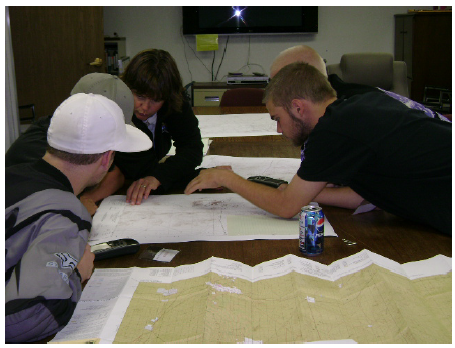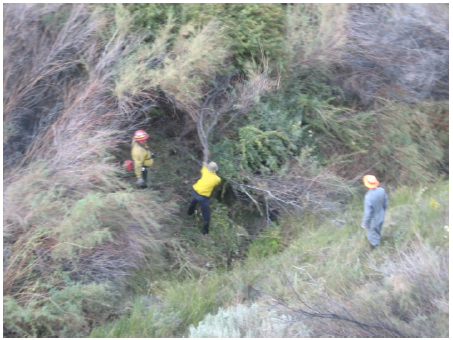Introduction
This fact sheet focuses on the Tonopah Bootstraps program and its participants’ developing self-awareness. Bootstraps is a 12-week program designed for rural youth who are not working and not in school. The program goal is for participants to develop skills and motivation to find meaningful work, which is accomplished through a combination of classroom learning and practical fieldwork. The environmental fieldwork on public lands, funded by the Bureau of Land Management, provides the venue for these disenfranchised youth to change their attitudes and values about work.
Preparing to go into the field for the week after the Monday morning classes
Program History
The Bootstraps program was developed by University of Nevada Cooperative Extension (UNCE) in collaboration with the BLM. It was created in response to recommendations from the Sage Grouse Conservation Team, which was tasked to improve rangeland habitat.
UNCE’s situational analysis revealed that Nevada has the highest rate nationally of youth not working and not in school (Annie E. Casey Foundation, 2009). This is particularly evident in remote, rural communities in central Nevada, where the economic downturn has limited employment opportunities for youth (Bureau of Labor Statistics, 2008).
Partnerships
The motivation for BLM involvement was the availability of this youth workforce that could work in remote public land locations. Modeled after the 1930s Civilian Conservation Corps (CCC) and the modern day California CCC (2009), Bootstraps is unique in bringing the BLM and other natural resources agencies into the collaboration as funders and program partners. Tonopah Bootstraps began in 2007, with fieldwork addressing the critical rangeland improvement issue of noxious weeds.
The Program
Bootstraps targets youth ages 18-21 who typically have limited positive leadership experience and role models. They are disengaged from the social and economic structure for many of the reasons that Brennan, Barnett, and Baugh (2007) indicate.
They do not work, are not in school, and frequently abuse drugs or alcohol. They are a transient group without a vision for their future. When entering the program, Bootstraps participants have few options and little ambition to improve their lives.
The program is based on transition into adulthood research (Piha & Hall, 2006). The goal is for graduates to develop life skills and work experiences while working on an environmental project. They complete fieldwork to control invasive weeds on BLM land in order to improve rangeland health. Participants are paid for a 40-hour work week, during which they camp at remote job site locations. Each team of five youth has an adult job coach who supervises them while they survey noxious weeds, spray herbicides, and maintain equipment.

Participants learn mapping and navigational skills during two-week training.
Throughout the hiring process and 12 weeks of employment, the concept that this is a life skills program and not long-term employment is reinforced. Job-related safety and technology skills development are goals of the initial two-week training.
Prior to leaving for the field on Monday mornings, University faculty teach the Bootstraps curriculum (Smith, Meier, & Davis, 2008), covering topics such as communication, goal-setting, conflict resolution, and job-seeking skills. The job coach uses the experiential learning process (Dewey, 1938) to apply life skills taught in the classroom to real-life examples in the field. Evenings around the camp provide opportunities for the group to reflect about work, school goals and teambuilding.
Method
The evaluation design was a multimethod descriptive case study as described by Stake (1995). Under the auspices of UNR’s Institutional Review Board, participants gave written consent to complete quantitative and qualitative tools, including pre- and post-program surveys, participant portfolios, job coach field observations and interviews. This fact sheet reports only qualitative data from the interviews because group size is not sufficient at this time to provide statistical validity.
Digitally recorded interviews were conducted with each Bootstraps participant during their first week, their last week, and one year following program completion. Each interview lasted between 15 and 35 minutes and was transcribed verbatim for analysis. The qualitative inquiry process followed is outlined by Hill, Thompson, and Williams (1997). A faculty member with experience in interview techniques completed 35 participant interviews. Specifically, 20 pre-program interviews were conducted with all of the participants; 12 post-program interviews were conducted with those who completed the program; three interviews were conducted one year after completion with young persons who could be found. Transiency among this population is very typical.
Our sample size reflected other researchers’ (Goetz & LeCompte, 1984) recommendations that the number be large enough to develop saturated data, which occurred in this study. Hill et al. specifically state samples in qualitative research should be small, containing 10-15 participants.
Data analysis followed a phenomenological approach (Moustakas, 1994) and was conducted by a group of faculty, including one who was not directly involved with Bootstraps. Three conceptual themes emerged: external responsibility for my situation, supportive people, and pride. A line-by-line textual analysis was conducted to provide clarification and depth to the themes.

Tamarisk clearing project with BLM fire crew, one of the Bootstraps projects.
Findings
External Responsibility
Interview statements at the beginning of the program revealed that participants believed they were out of work and not in school as a result of something external, rather than their own doing. Past or potential employers were blamed. For example, one interviewee said, “…the gas station told me that I didn’t have a professional gas station look, so they weren’t going to hire me (quote from 19 year-old male with extensive piercings and tattoos).”
During the post-program interviews, participants reflected on their work experience in Bootstraps and the changes they saw in themselves. “We started getting responsible and stopped messing around. We went to work on time…didn’t really miss any days…we just stopped acting like little kids.”
Supportive People
Many participants had few or no supportive people in their lives. They indicated that they valued support from program staff and recognized the team aspect that assisted in their successful completion of Bootstraps. These relationships were believed to be major contributors to participant success over time. One interviewee said, “I can always come back if I need help with my resume...” and then listed how each staff member continues to support him. Another interviewee said, “…automatically he (the job coach) starts knowing your interests, what you want to do, so he can later on help you with that.”
Pride
Another theme that was revealed was pride associated with the job they had performed. Participants felt that they had a prestigious job because they were getting paid well to do specialized environmental work.
While some interviewees focused on the paycheck, others highlighted the nature of the work including one who said, “…the stuff we’re doing is kind of serious, especially with herbicides.” They also placed high value on the technology they learned on the job. “…makes you feel good because you actually are important in some way. You get to use something that somebody else can’t.” Other interviewees suggested that they felt good about saying that they worked for the University because such jobs were generally not available to youth in rural communities. One said, “You just can’t get this work in (this) town.”
Conclusions
Extension professionals are being called upon to participate in workforce preparation programs during the economic recovery. While still a fledgling program, Bootstraps is gaining attention as a potential model for youth employment programs in Nevada. Participant interview data revealed important changes from the beginning to the end of the program in the program participants. Specifically, participants expressed changes in acceptance of responsibility for their current situation and future direction, a recognition and willingness to use community resources for help, and ability to take pride in their work. The added component of partnering with the BLM to complete environmental projects adds an important element to this program. The Bootstraps curriculum and evaluation plan that includes both quantitative and qualitative instruments are being used to replicate the program in other Nevada communities.
References
Annie E. Casey Foundation. (2009). Kids Count Data Book. Retrieved August 18, 2009, from Data Center
Brennan, M., Barnett, R., & Baugh, E. (2007). Youth involvement in community development: Implications and possibilities for Extension. Journal of Extension [Online], 45(4) Article 4FEA3. Available at: JOE
Bureau of Labor Statistics. (2008). Employment and unemployment among youth. Retrieved August 12, 2009 from BLS
California Conservation Corps. (2009). Retrieved August 12, 2009 from CCC
Dewey, J. (1938). Experience and Education. New York: Macmillan.
Goetz, J., & LeCompte, M. (1984). Ethnography and qualitative design in educational research. New York: Academic Press. Hill, C., Thompson, B., & Williams, E. (1997). A guide to conducting consensual qualitative research. Counseling Psychologist. 25, 517-572.
Moustakas, C. (1994). Phenomenological research methods. Sage: Thousand Oaks, CA.
Piha, S., & Hall, G. (eds.). (2006). Special Issue: Preparing Youth for the Crossing: From adolescence to early adulthood. New Directions for Youth Development. 111, 1- 129. Retrieved December 8, 2008, from WOL
Smith, M., Meier, A., & Davis, R. (2008). Bootstraps Student Workbook. University of Nevada Cooperative Extension Curriculum, CM-08-09. Available online at: UNCE
Stake, R. (1995). The Art of Case Study Research. Sage: Thousand Oaks, CA.
Meier, A., Smith, M., and Usinger, J.
2010,
Bootstraps Program Provides Work Experience for Rural Youth in Tonopah,
Extension, University of Nevada, Reno, FS-10-01


